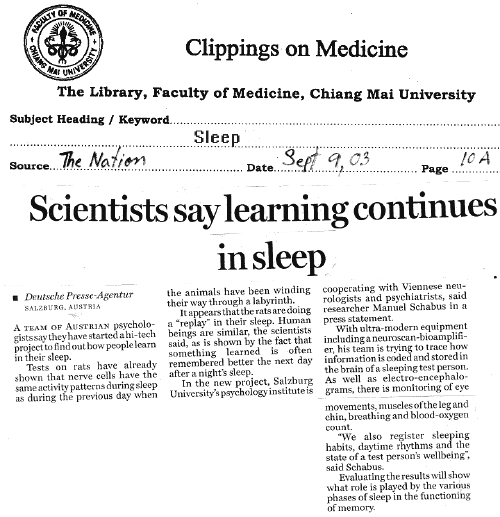Sleep Learning – Latest Research

Below you will find extracts from recent articles and reports on the latest research to have been performed in the field of sleep learning.
Sleep learning will enable you to to dramatically enhance your learning capabilities by tapping into the latest research.
More has been discovered about how the human brain works in the last 15 years than in all history to date.
Latest Research On Sleep Learning
New Scientist – The World’s No.1 Science & Technology News Service
Babies learn in their sleep
Students should be jealous – not only do babies get to doze their days away, but they have also mastered the art of learning in their sleep.
By the time babies are a year old they can recognize a lot of sounds and even simple words. Marie Cheour at the University of Turku in Finland suspected they might progress this fast because they learn language while they sleep as well as when they are awake.
To test the theory, Cheour and her colleagues studied 45 newborn babies in the first few days of their lives. They exposed all the infants to an hour of Finnish vowel sounds – one that sounds like “oo”, another like “ee”, and a third boundary vowel peculiar to Finnish and similar languages that sounds like something in between. EEG recordings of the infants brains before and after the session showed that the newborns could not distinguish between the sounds.
Fifteen of the babies then went back with their mothers, while the rest were split into two sleep-study groups. One group was exposed throughout their night-time sleeping hours to the same three vowels, while the others listened to other, easier-to-distinguish vowel sounds.
Brainwave
When tested in the morning, and again in the evening, the babies who had heard the tricky boundary vowel all night showed brainwave activity indicating that they could now recognize this new sound. They could identify the sound even when its pitch was changed, while none of the other babies could pick out the boundary vowel at all.
Cheour doesn’t know how babies accomplish this night-time learning, but she suspects that the special ability might indicate that unlike adults, babies don’t “turn off” their cerebral cortex while they sleep. The skill probably fades in the course of the first year of life, she adds – so forget the idea that you can pick up tricky French vowels as an adult just by slipping a language tape under your pillow.
But while it may not help grown-ups, Cheour is hoping to use the sleeping hours to give remedial help to babies who are genetically at risk of language disorders.
Journal reference: Nature (vol 415, p 599) Alison Motluk
Subliminal study shows subconscious learning is possible
Subconscious learning probably is possible, say US researchers. What’s more, subconscious learning may affect our conscious decisions – without our realizing it.
Takeo Watanabe and his colleagues at Boston University found that people who had watched a particular direction of subliminal dot movement during a letter-naming trial were significantly better at picking it out later.
The finding challenges the idea that attention is an essential element of the learning process. “Attention can make learning more efficient,” says Watanabe, “but it’s not necessary.”
Watanabe dismisses gimmicks such as cassettes that purport to teach you while you sleep. But he speculates that listening to a foreign language being spoken at low volume – loud enough that your brain can perceive it but not so loud that you are aware – could improve a person’s pronunciation and listening skills. “It could be useful,” he says.
Cognitive aspects such as sentence structure and semantics would not be affected, he suspects.
Dancing dots
Watanabe’s team asked volunteers to name certain letters presented on a screen. Meanwhile, behind the letters, dots danced randomly – or so it appeared. In fact, one in 20 shared a direction. This was just below the threshold of conscious perception.
The volunteers did this letter-naming task for an hour every day for a month. Then they were asked to do another series of tests. These involved watching moving dots and identifying any underlying pattern, or saying whether two displays of dots moved in the same direction. In both of these cases only about one in 10 dots were moving coherently – an activity that was just above the conscious threshold.
The team found that people who had watched a particular direction of movement during the first series of tests were significantly better at picking it out later.
Advertising influence
“I think it’s one of the nicest sets of data I’ve seen for learning outside of perceptual awareness,” says Phil Merikle, at the University of Waterloo in Canada.
But there’s an important conclusion that the authors don’t stress, he says. The study shows that what the volunteers learned subconsciously during the trials influences their conscious experience.
“This perceptual learning is influencing how they see the world,” says Merikle. Subconscious learning may affect our conscious decisions – without our knowing it. “It’s what advertisers have known all along: if we just keep the exposure rate up, people will be influenced.”
Journal reference: Nature (vol 413, p 844) Alison Motluk